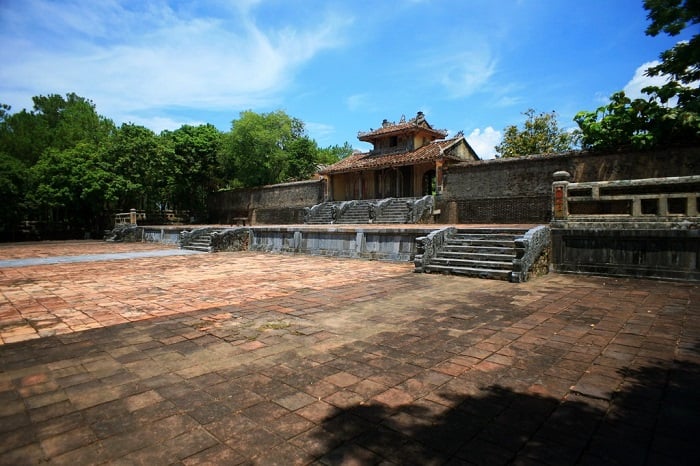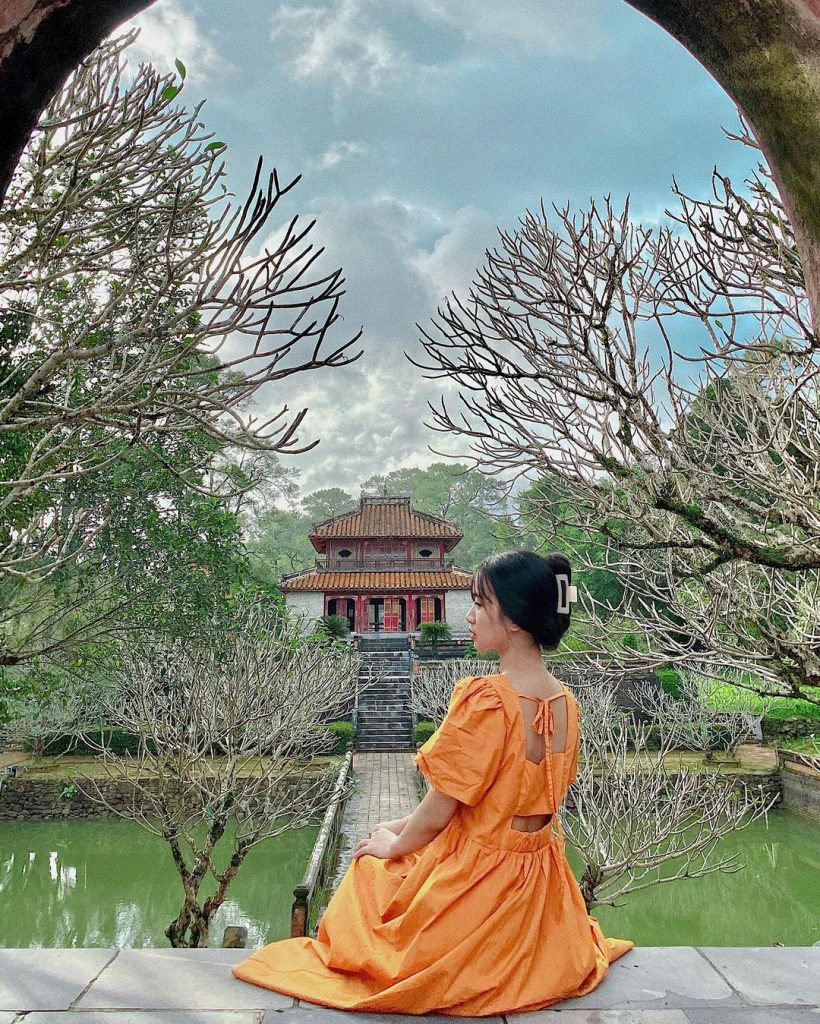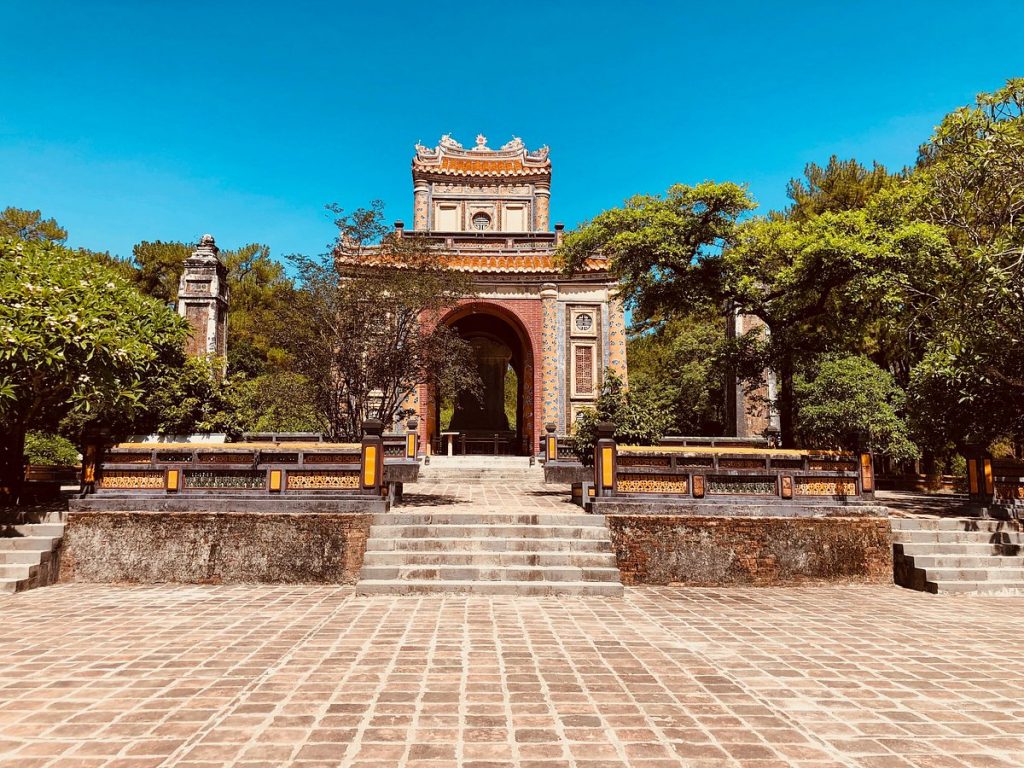The tomb of King Thieu Tri in Hue is one of the famous tombs recognized by UNESCO as a World Cultural Heritage Site in 1993. Let’s explore the fascinating features of this beautiful and captivating architectural complex. Situated in a picturesque landscape, distinguished by its unique architecture, intricate carvings, and harmonious design, the tomb of King Thieu Tri in Hue remains a destination rich in historical value, attracting numerous travelers to visit when they come to the ancient capital.
Table of Contents
Introduction to the Tomb of King Thieu Tri in Hue
Where is the Tomb of King Thieu Tri located?
The historical site of the Tomb of King Thieu Tri in Hue is nestled amidst vast hills in the area of Cu Chanh village, Thuy Bang commune, Huong Thuy district, approximately 8km from the city center of Hue.
If you’re looking for a means of transportation to get to the Tomb of King Thieu Tri, the private car rental service with a driver in Hue provided by DanangPrivateCar.com will help ensure you have a safe and comfortable journey. With our private car service, we will pick you up and drop you off at your destination. While you explore, our driver will wait for you at no extra cost, and our transparent pricing will help you have the most cost-effective trip. Additionally, if you’re in Da Nang or Hoi An, you can book a day trip from Da Nang to Hue to visit various attractions in Hue
The Formation Process of the Tomb of Thieu Tri in Hue
The Tomb of Thieu Tri is also known by another name, Xương Lăng, serving as the resting place of King Thieu Tri – the third monarch of the Nguyễn Dynasty and the eldest son of King Minh Mạng. King Thieu Tri ascended the throne for 7 years before falling seriously ill and passing away on November 4th, 1847. As the tomb had not been constructed yet, the king’s remains were temporarily kept at Long An Palace within Bao Dinh Imperial Complex for 8 months.
Before his passing, King Thieu Tri had instructed his son (King Tu Duc) regarding the construction of his tomb. Consequently, the Tomb of King Thieu Tri features a rather distinctive architectural style compared to the tombs of his predecessors. It is also the only tomb facing the Northwest – a direction uncommon in the architectural works of tombs or palaces during the Nguyễn Dynasty.

After King Thieu Tri’s demise, construction of the tomb for his father began under King Tu Duc reign in February 1848. By March 1848, the Toại Đạo (the main pathway) and the tunnel for transporting the king’s coffin into the tomb were completed. In November 1848, the memorial stone tablet inscribed with a lengthy eulogy of over 2,500 characters, composed by King Tu Duc himself, was erected.
The main architectural structures of the tomb were completed by May 1848. King Tu Duc personally inspected the construction for the final time in June 1848, and approximately 10 days later, King Thieu Tri’s remains were laid to rest inside the tomb.
The Unique Architectural Features of the Tomb of King Thieu Tri
The structure of the Tomb of King Thieu Tri in Hue consists of two main areas: the tomb axis on the right side and the sacrificial axis on the left side.
- Tomb Axis: The main tomb area is located in a picturesque setting, with the Nhuan Trach Lake in front, connected to the Điện Lake in the Sacrificial area through an underground drainage system. Behind the Nhuận Trạch Lake is a screen wall and the Nghi Mon Gate made of cast bronze in the “dragon vein bronze pillar” style leading to the Bai Dinh Courtyard, continuing to the Bi Dinh and the Duc Hinh Pavilion.
- Sacrificial Axis: This worship area is situated 100 meters to the left of the Duc Hinh Pavilion and is constructed differently. To reach the Bieu Duc Palace (where the worship of King and Queen Tu Du is performed), one passes through the Nghi Môn Gate made of jade stone and the Hong Trach Gate.
Strong Rural Charm in the Surrounding Walls
Unlike other royal tombs in Hue, the Tomb of Thieu Tri does not have surrounding walls; instead, natural hills and artificial mounds in the surrounding area are used to create screen walls and rear curtains. It can be said that the tomb is surrounded by rice fields and green gardens, giving it a deep rural, serene, and tranquil atmosphere.

Unique Orientation of the Tomb
The Tomb of King Thieu Tri faces the Northwest, a direction not commonly used in prominent architectural structures in Hue at that time. However, considering Feng Shui, it aligns with the principle of “mountain facing water,” symbolizing prosperity. Additionally, the Vọng Cảnh hill, located about 1km from the tomb, and the Ngoc Tran mountain on the left side, facing towards the tomb, create the “guardian dragon watching over tiger” position for the tomb. The “forecourt” for the tomb area is the Chằm mountain about 8km away, and the Bau Ho cave, located closer, acts as a natural barrier for the sacrificial area.

The Surrounding Landscape of the Tomb of Thieu Tri
Surrounding the Tomb of King Thieu Tri in Hue is the tranquil scenery of the countryside, with lush green trees, vast stretches of verdant rice fields, and the system of tombs of his mother, wife, kings, queens, and the offspring of King Thieu Tri gathering and reuniting.

Slightly ahead of the Tomb of King Thieu Tri in Hue is the Tomb of Hieu Dong (his mother – Lady Ho Thi Hoa), behind and to the left is the Tomb of Xuong Tho (his wife – Lady Tu Du), while in front lies the “tảo thương” burial area, the resting place of kings, petite queens, and the offspring of King Thieu Tri.
Ticket Prices for Visiting the Tomb of King Thieu Tri in Hue
The ticket price for visiting the Tomb of King Thieu Tri in Hue is the same for both Vietnamese and international visitors, set at 50,000 VND per adult ticket, FREE for children.
Other Famous Royal Tombs of the Nguyen Dynasty in Hue
The tombs of the Nguyen Dynasty kings are all distinguished by their unique architecture and hold significant historical value across different periods.
Khai Dinh Tomb
Khai Dinh Tomb stands out among the seven royal tombs of the Nguyen Dynasty for its unique architecture, blending Eastern and Western styles influenced by various architectural schools such as Buddhism, Roman, Indian, and Gothic.

Minh Mang Tomb – One of the Three Most Unique Royal Tombs in Hue
Minh Mang Tomb is renowned for its favorable Feng Shui and picturesque scenery. Additionally, its architectural features are exceptionally prominent. The tomb complex consists of 40 large and small structures arranged along a central axis.

Tu Duc Tomb
When visiting Hue, do not miss Tu Duc Tomb, known as the most beautiful among the seven royal tombs of the Nguyen Dynasty, built during King Tu Duc’s reign. This tomb boasts architectural features with a sense of grandeur, soft lines, along with beautiful natural surroundings, providing a delightful experience.

Here are some notes to remember when visiting the Tomb of King Thieu Tri in Hue
As it is a place of solemnity and worship, please take note of the following during your visit to the Tomb of King Thieu Tri in Hue:
- Pay attention to dressing modestly and respectfully, avoiding revealing or offensive attire.
- Maintain orderliness, refrain from playing around, and avoid speaking loudly.
- Follow the regulations set by the tourism management authority, respect the significance of the site, refrain from touching artifacts, and avoid climbing on statues or sacred objects.
- Preserve general cleanliness, refrain from littering, as it affects the surrounding landscape
The Tomb of King Thieu Tri in Hue is an enticing destination that visitors should not overlook when exploring the ancient capital to witness the rich historical value and unique architectural features of the royal tombs. Refer to the information provided in the article to plan your visit to the Tomb of Thieu Tri effectively. Wishing you a joyful and fulfilling journey.

Comments